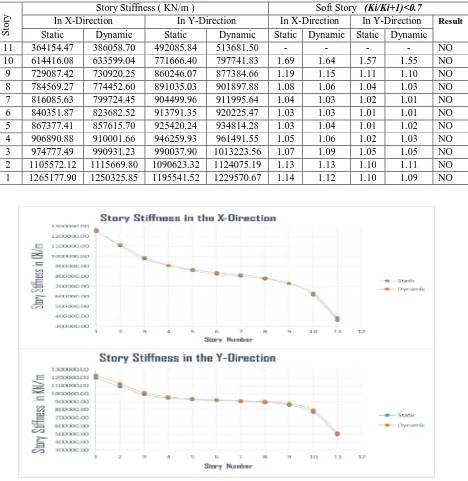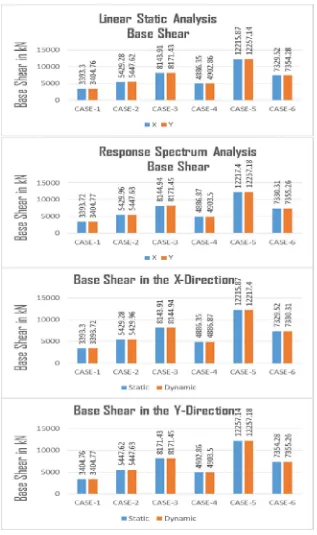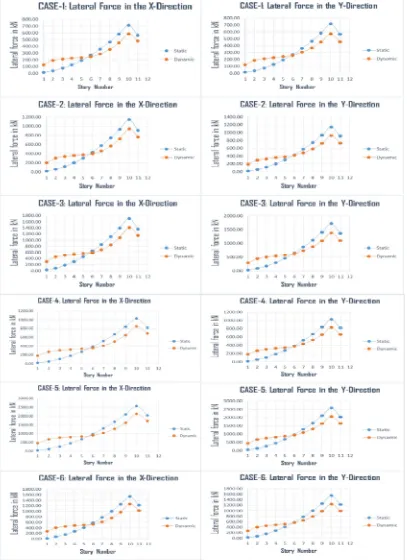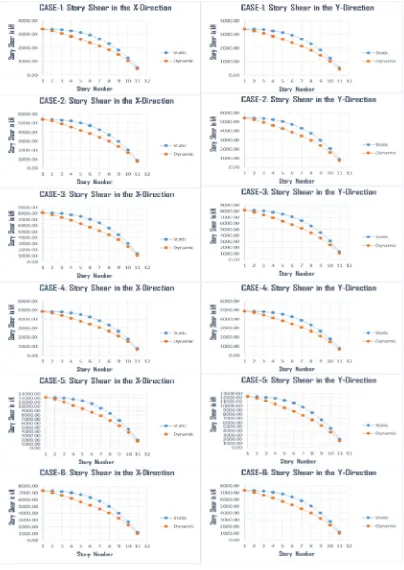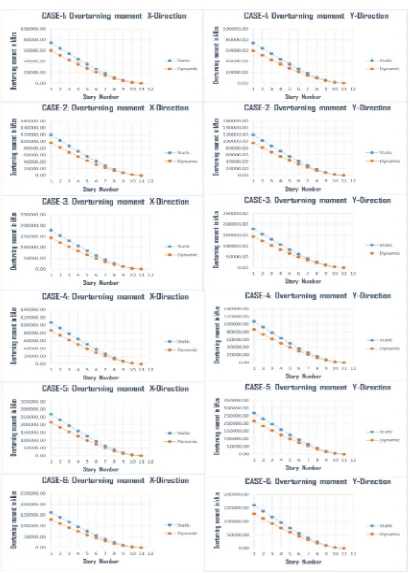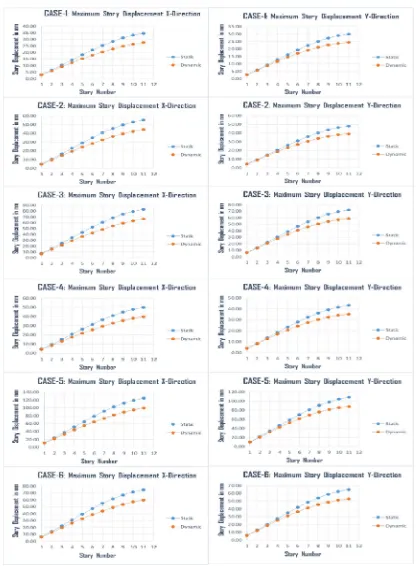Seismic Analysis of a Multistorey RC Frame
Building in Different Seismic Zones
Girum Mindaye1, Dr. Shaik Yajdani2
M.Tech Student, Department of Civil Engineering, Andhra University College of Engineering (A), Visakhapatnam,
Andhra Pradesh, India1
Associate Professor, Department of Civil Engineering, Andhra University College of Engineering (A), Visakhapatnam,
Andhra Pradesh, India2
ABSTRACT: The analysis of a structural system to determine the deformations and forces induced by applied loads or ground excitation is an essential step in the design of a structure to resist earthquake. There is a range of methods from a linear analysis to a sophisticated nonlinear analysis depending on the purpose of the analysis in the design process. In this paper seismic response of a residential G+10 RC frame building is analysed by the linear analysis approaches of Equivalent Static Lateral Force and Response Spectrum methods using ETABS Ultimate 2015 software as per the IS-1893-2002-Part-1. These analysis are carried out by considering different seismic zones, medium soil type for all zones and for zone II & III using OMRF frame type and for those of the rest zones using OMRF & SMRF frame types. Different response like lateral force, overturning moment, story drift, displacements, base shear are plotted in order to compare the results of the static and dynamic analysis
KEYWORDS: Equivalent Static Analysis, Response Spectrum Analysis, Lateral Force, Base Shear, overturning Moment, Story Drift, Story Stiffness
I. INTRODUCTION
When earthquakes occur, a buildings undergoes dynamic motion. This is because the building is subjected to inertia forces that act in opposite direction to the acceleration of earthquake excitations. These inertia forces, called seismic loads, are usually dealt with by assuming forces external to the building. So apart from gravity loads, the structure will experience dominant lateral forces of considerable magnitude during earthquake shaking. It is essential to estimate and specify these lateral forces on the structure in order to design the structure to resist an earthquake. The ductility of a structure is the most important factors affecting its seismic performance and it has been clearly observed that the well-designed and detailed reinforced structures behave well during earthquakes and the gap between the actual and design lateral force is narrowed down by providing ductility in the structure.
The following are the advantages of a reinforced concrete structure having sufficient ductility:
A ductile reinforced concrete structure may take care of overloading, load reversals, impact and secondary stresses due to differential settlement of foundation.
A ductile reinforced concrete structure gives the occupant sufficient time to vacate the structure by showing large deformation before its final collapse. Accordingly, the loss of life is minimized with the provision of sufficient ductility.
Properly designed ductile joints are capable of resisting forces and deformations at the yielding of steel reinforcement. Therefore, these sections can reach their respective moment capacities, which is one of the assumptions in the design of reinforced concrete structures by limit state method.
The literature review begins with the coverage of general earthquake engineering topics.
[1] AnirudhGottala, Kintali Sai Nanda et al (2015)carried out comparative study of static and dynamic seismic analysis of a multistorey building. A multi-storied framed structure of (G+9)pattern is selected. Linear seismic analysis is done for the building by static method (Seismic Coefficient Method) and dynamic method (Response Spectrum Method) using STAAD-Pro as per the IS-1893-2002-Part-1. A comparison is done between the static and dynamic analysis, the results such as Bending moment, Nodal Displacements, Mode shapes are observed, compared and summarized for Beams, Columns and Structure as a whole during both the analysis.
[2] B. Srikanth and V. Ramesh (2013) comparative study of seismic response for seismic coefficient and response spectrum methods. In this thesis, the earthquake response of symmetric multi-storied building by two methods are studied. The methods include seismic coefficient method as recommended by IS Code and modal analysis using response spectrum method of IS Code in which the stiffness matrix of the building corresponding to the dynamic degrees of freedom is generated by idealizing the building as shear building. The responses obtained by above methods in two extreme zones as mentioned in IS code i.e. zone II and V are then compared. Test results Base Shears, Lateral Forces and Storey Moments are compared.
[3] Mohit Sharma and Dr. Savita Maru (2014) studied about dynamic analysis of multistore G+30 regular building. These buildings have the plan area of 25m x 45m with a storey height 3.6m each and depth of foundation is 2.4 m. & total height of chosen building including depth of foundation is 114 m. The static and dynamic analysis has done on computer with the help of STAAD-Pro software using the parameters for the design as per the IS-1893- 2002-Part-1 for the zones- II and III and the post processing result obtained has summarized.
[4] Sayed Mahmoud and Waleed Abdallah Saudi Arabia (2014) have done a research on response analysis of multi-story RC buildings under equivalent static and dynamic loads according to Egyptian code. The objective of this research is to assess the seismic performance of an existing shear wall residential building located in Cairo. Both dynamic response spectrum (RS) and equivalent static force (ESF) methods are used in the seismic analysis. The design RS curve suggested by the Egyptian Code (EC) for seismic design is utilized to perform the dynamic analysis. The response analysis of the building under the acting seismic loads has been performed using ETABS, universal finite element analysis software for dynamic analysis. The results of the study show significant differences in building's responses obtained using ESF and RS analysis methods. It has been found that the application of static method in a specified direction results in responses in the same direction. However, the applications of dynamic RS method induces response in both directions regardless the direction of loading.
III. METHODSOFANALYSIS
The most commonly used methods of analysis for determining the design seismic forces acting on a structure as a results of ground shaking are based on the approximation that the effects of yielding can be accounted for by linear analysis of the building, using the design spectrum for inelastic systems. Forces and displacements due to each horizontal component of ground motion are separately determined by analysis of an idealized building having one lateral degree of freedom per floor in the direction of the ground motion component being considered. Such analysis may be carried out by the equivalent static procedure (static method) or response spectrum analysis procedure (dynamic method). Both the equivalent static and response spectrum analysis procedures lead directly to lateral forces in the direction of the ground motion component. The significant difference between linear static and linear dynamic analysis is the level of the forces and their distribution along the height of the structure. The equivalent static method is mainly suited for preliminary design of the building. The preliminary design of the building is then used for response spectrum analysis or any other refined method such as the elastic time history method. For this study, seismic analysis is carried out by linear static analysis and response spectrum analysis.
IV. MODELOFTHEPROJECT
Building type: G+10 Residential Building
Plan area: 26.5(m)*26.7(m)
Beam size: 300(mm)*400 (mm)
Column size: 500(mm)*500 (mm)
Bam clear cover to Longitudinal Rebar Group centroid: 60 mm Column clear cover to confinement Bars: 40 mm
Slab thickness: 150mm
Typical storey height: 3m
Bottom storey height: 4m
Live load, LL: 3kN/m²
External Wall load: 11.44kN/m
Partition and floor finishing load, FL: 2kN/m2
Earthquake Direction: X and Y
Seismic Zone: II, III, IV and V
Soil type: Type II (Medium Soil)
Materials: M30 and Fe415
Axes Spacing is 4m except between of axis 4 & 5 is 2.7m and axis D & E is 2.5m
The model is divided into six cases depending on the location of seismic zones and frame type of the building as follows:
V. SEISMICANALYSISRESULTS
Seismic analysis carried out by the help of ETABS and the results of Story stiffness, base shear, lateral force, story shear, story displacement, overturning moment and story drift from both linear static and response spectrum analysis were compared each for six cases.
Table-1 Stiffness Irregularity Checking
S
tory
Story Stiffness ( KN/m ) Soft Story (Ki/Ki+1)<0.7
In X-Direction In Y-Direction In X-Direction In Y-Direction Result Static Dynamic Static Dynamic Static Dynamic Static Dynamic
11 364154.47 386058.70 492085.84 513681.50 - - - - NO 10 614416.08 633599.04 771666.40 797741.83 1.69 1.64 1.57 1.55 NO 9 729087.42 730920.25 860246.07 877384.66 1.19 1.15 1.11 1.10 NO 8 784569.27 774452.60 891035.03 901897.88 1.08 1.06 1.04 1.03 NO 7 816085.63 799724.45 904499.96 911995.64 1.04 1.03 1.02 1.01 NO 6 840351.87 823682.52 913791.35 920225.47 1.03 1.03 1.01 1.01 NO 5 867377.41 857615.70 925420.24 934814.28 1.03 1.04 1.01 1.02 NO 4 906890.88 910001.66 946259.93 961491.55 1.05 1.06 1.02 1.03 NO 3 974777.49 990931.23 990037.90 1013223.56 1.07 1.09 1.05 1.05 NO 2 1105572.12 1115669.80 1090623.32 1124075.19 1.13 1.13 1.10 1.11 NO 1 1265177.90 1250325.85 1195541.52 1229570.67 1.14 1.12 1.10 1.09 NO
Fig.8 Story Drift
Fig.10 Overturning Moment
VI. CONCLUSIONS
Dynamic story shear is less than static story shear for all cases.
From all cases, it is concluded that lateral force obtained from response spectrum method is higher than those obtained by equivalent static lateral force method for story one up to five and the rest higher stories have less values.
The maximum story displacement, overturning moment obtained from response spectrum method is lesser than those obtained by equivalent static lateral force method.
For the case-5 (Zone-V & OMRF), the static displacement of the story exceeds the limitation of the maximum story drift ratio of 0.004. The followings are the stories which exceed the maximum drift limitation: in the X-Direction:- Story 2-7 and in the Y-X-Direction:- Story 3-5
Hence zone-V is extremely exposed to earthquake rather than increasing the dimension of columns, it’s preferable to use SMRF frame type for the same dimension of columns.
Story stiffness is varying in X- and Y-directions for both methods. Because lateral stiffness of a story is not a stationary property, but an apparent one that depends on lateral load distribution.
The base shear, lateral force, story shear, maximum story displacement and overturning moment are increased in both directions (i.e., X & Y) as the seismic zone goes from II to V for the same frame type building in both methods.
The use of SMRF frame type in zones IV and V, reduced the values of base shear, lateral force, story shear, Overturning Moment and maximum story displacement which obtained by using OMRF frame type by 40.0% for both methods.
If a building is designed as an SMRF frame, it needs to be designed only for lesser forces than if it is designed as an OMRF frame.
Equivalent static lateral force method gives higher values of forces and moments which makes building uneconomical hence consideration of response spectrum method is also needed.
REFERENCES
[1] A.K Chopra "Dynamic of structures theory and Earthquake Engineering" fourth edition,Prentice Hall, 2012
[2] AnirudhGottala, Kintali Sai Nanda Kishore and Dr. Shaik Yajdhani “Comparative Study of Static and Dynamic Seismic Analysis of a Multistoried Building” International Journal of Science Technology & Engineering, Volume 2, Issue 01, July 2015
[3] B. Srikanth and V.Ramesh "Comparative Study of Seismic Response for Seismic Coefficient and Response Spectrum Methods", International Journal of Engineering Research and Applications,ISSN : 2248-9622, Vol. 3, Issue 5, Sep-Oct 2013, pp.1919-1924
[4] ETABS Design Manuals
[5] Gary C. Hart, Kevin Wong “Structural Dynamics for Structural Engineers” John Wiley & Sons Inc.
[6] IS 875(Part2) – 1987 “Code of practice for design loads (other than earthquake) for buildings and structures”, Part 2 Imposed Loads, Second revision,Sixth reprint June 1998.
[7] IS 1893(part 1) : 2002, “ Criteria for earthquake resistant design of structures, part 1, general provisions and buildings “, Fifth revision, 2002
[8] K.V. Vijayendra “Earthquake resistant design of structures (Subject Code: 06CV834)” Department of Civil Engineering, BIT, Bangalore, VTU Learning
[9] Mohit Sharma andDr. Savita Maru“Dynamic Analysis of Multistoried Regular Building”IOSR Journal of Mechanical and Civil Engineering (IOSR-JMCE)e-ISSN: 2278-1684,p-ISSN: 2320-334X, Volume 11, Issue 1 Ver. II (Jan. 2014), PP 37-42
[10] Pankaj Agarwal ,Manish Shrikhande "Earthquake Resistant Design Of Structures” Prentice Hall of India private limited, 2006
[11] Sayed Mahmoud and Waleed Abdallah Saudi Arabia "Response Analysis of Multi-Story RC Buildings under Equivalent Static and Dynamic Loads according to Egyptian Code ", International Journal of Civil and Structural Engineering Research, ISSN 2348-7607 (Online), Vol. 2, Issue 1, pp: (79-88), Month: April 2014 - September 2014
